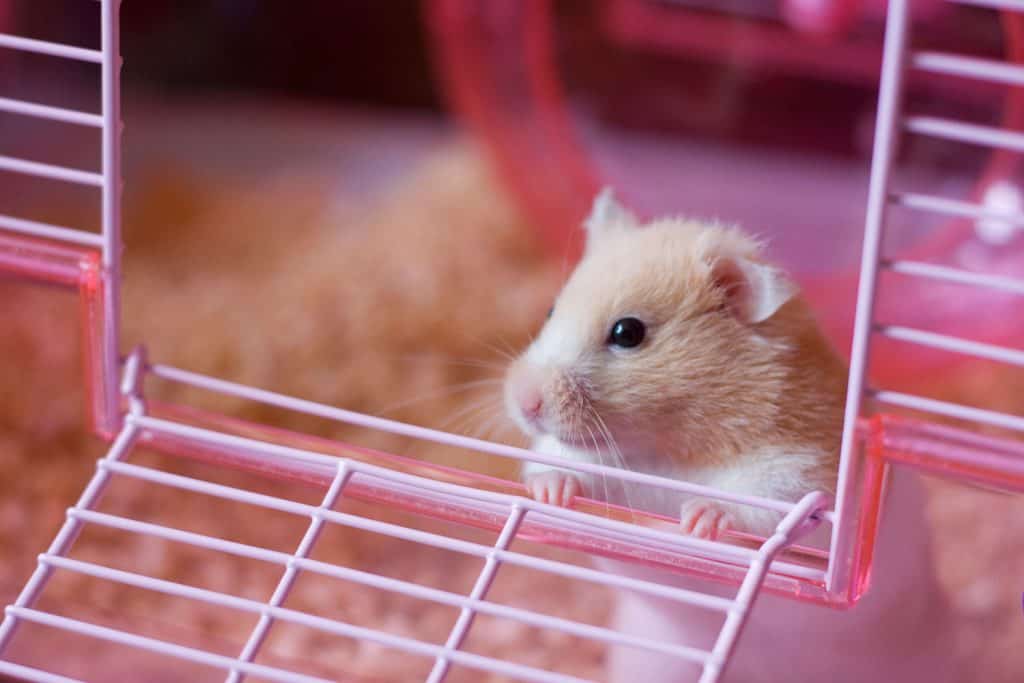Does your hamster hide? You may be curious why your hamster likes to tuck their small furry body into the corner of its cage. Or perhaps you're concerned something is wrong when you notice them hide beneath their bedding when you enter the room. We were wondering the very same thing, so researched the topic and prepared this special guide for hamster owners!
The main reason for hamsters to hide is just normal burrowing behavior. If you have a hamster, you might notice a lot of movement happening beneath their bedding. These cute little rodents love to explore, burrowing and making hideaways along the way for play and sleep. You may also notice your hamster hiding in their play structures or tunnels. They love finding places to hide their food when they aren’t storing it in their chubby cheeks of course. Hamsters are curious creatures by nature, hiding and burrowing is simply part of what they like to do!
Most of the reasons why your hamster hides are healthy and normal! hamsters have many quirky but common behaviors and one the most popular hamster trait is burrowing and hiding! However, there are caveats. Sometimes, a hamster's hiding behavior - especially if relatively new or sudden, can indicate a problem. Read on to learn the different reasons why your hamster is hiding and see if there's anything you need to be doing about it.
Hiding Behaviors in Hamsters
Your hamster may be hiding for a variety of reasons. They may be trying to tell you something about how they are feeling or they simply be engaging in normal, playful hamster behavior.

hamsters use body language to show their owners how they are feeling. Your hamster may be tired, disappearing in the corner or hidden away beneath their bedding to rest. Hamsters are nocturnal, so they hide away during the day to sleep and are active at night.
If your hamster runs away to hide when you or a friend enter the room, they might be stressed. Maybe you’ve just recently brought your hamster home and your hamster isn’t familiar with you just yet. Give it time! Your hamster will warm up to you and your presence. Try to limit loud noises or abrupt disruptions. This includes limiting the presence of over-eager children who might accidentally startle your hamster. Hamsters will usually only bond emotionally with one or two people. They might hide away when your friend comes in to the room but will come out of hiding when they see their friend - you!
Do you have more than one hamster in a habitat? Sometimes hamsters hide from other hamsters if one or more are being too aggressive. Make sure you keep an eye on your hamster's behavior. If you notice one or more hamster being aggressive, you may need to separate them, placing them in to separate habitats to encourage better behavior.
Is your hamster's food dish is empty but you just fed them? Don’t fill it up again just yet! Hamsters are known to hide their food. In fact, they’re happiest when they’re stowing away their grub, hiding food in various corners of their habitat and in their cheeks.
Is hiding behavior affected by the hamster's breed?
Some hamster breeds enjoy being alone while others are naturally more social than others. Depending on the breed of hamster you own, your hamster might hide more than another. Just like people, hamster behavior varies depending on your hamster's personality.
Three of the most common hamster breeds are Syrian hamsters, Dwarf hamsters, and Chinese hamsters. While they share many similar traits not all hamsters are the same. Each breed and individual hamster has their own distinct temperament.

- Syrian hamsters are docile when separated but can get aggressive when kept together. They should be kept only one to a cage to avoid fighting and hiding due to fear.
- Dwarf hamsters are also known as Russian, Roborovski, or Cambell’s hamsters. These breeds are quite social but should be kept only with their own species.
- Chinese hamsters can be quite social but not in every case. If you have more than one Chinese hamster in a habitat and notice them hiding, they may prefer to live in separate homes. It’s important to pay close attention to your hamster if you let them out of their habitat - this breed of hamster is quite fast! They may run away quickly to explore and you might have trouble finding them in their new hiding space. They are also very small.
Changes in hamster behavior (when it may indicate a problem)
There are occasions when your hamster hiding is more than burrowing and may actually mean there is a health issue. Keep an eye on your hamster and if you notice any abnormal behavior, they may be ill. Remember to always seek professional veterinary care if you notice your hamster experiencing worrisome behavior.
Your hamster is inactive at night
If you notice your hamster is hiding and also being quite lazy or lethargic during the day and night, they might be sick.

Your hamster will want to sleep during the day but if they continue to frequently hide at night, it is an indication that they are unwell. It is best to seek veterinary care and a professionals opinion of how you should care for your hamster.
Keep an eye on room temperature
Hamsters prefer to be kept warm. If you notice your hamster is hiding more than usual, it may be the room temperature has lowered and your hamster is unable to keep warm. They may even seem to go into hibernation. You may want to invest in a heat lamp or simply need to turn up the heat in your home.
How to get your hamster to stop hiding
If you believe your hamster's hiding is excessive, there are some things you can do at home to help your furry friend get back on the right track. Normal hamster behavior can be encouraged by engaging in some simple but helpful practices. A healthy habitat is a great place to start!
Provide lots of space to run and play!
Hamsters love to run - even as much as 5 miles per day! A good-sized hamster home with accessories is important. There are many options including a climbing tube, hamster wheel, and activity ball. If your hamster is being less active, it may be because they are understimulated and need different play equipment to keep them moving.

There are cheap and effective solutions too - give your hamster an empty toilet paper roll to chew on and play with!
Let your hamster sleep without interruption
Put your hamster cage in a room where they will have the freedom to sleep during the day and play at night. This will encourage your hamster to feel comfortable enough to engage in a healthy routine. It’s best not to put your hamster in a room where the lights will be turned on and off at erratic hours.
Remember, not all cages are created equal
Your cage needs will vary depending on the breed, size of your hamster, and how many hamsters you have. If you notice your hamster hiding in one area only it may be they need a larger space. You might want to try a bigger habitat with appropriate bedding for your hamster to burrow and explore.

Give your hamster time to adjust
When you bring your hamster home, you might be excited to hold your hamster and you may want to put your hand in your hamster's cage to pet them. We understand they are so darn cute! But you might want to give your hamster space. Moving to a new home, in a new and strange environment, might be unsettling or even frightening for your hamster. Let your hamster have time to warm-up to their new home and adjust to the presence of a new friend - you! It won’t be long before your furry little friend is excited to see you and can’t wait to show what they can do.
Hamsters are curious and cute little rodents. If you notice your hamster burrowing and hiding remember, that is completely normal! Hiding during the day and burrowing away to create tunnels or hide their food is very common. Excessive hiding can be concerning and might be a sign that something is wrong. It’s important to monitor your hamster’s behavior without disrupting their natural habits. If you believe your hamster is hiding because they are unwell or ill, it is important to seek professional medical advice for your pet. With proper care, your hamster will live a happy and healthy life that you both will cherish!




why dose my hamsters always hide behind their wheels?